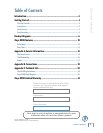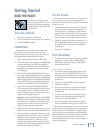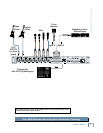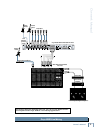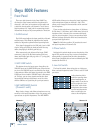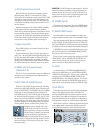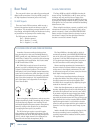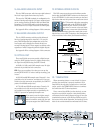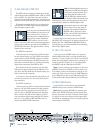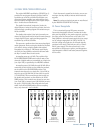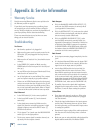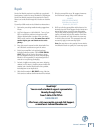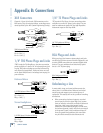
11
Owner’s Manual
Owner’s Manual
6. 48V Phantom Power Switch
Most professional condenser microphones require
phantom power, which is a low-current DC voltage
delivered to the microphone on pins 2 and 3 of the XLR
microphone connector. Push in the 48V button if your
microphone needs phantom power. An LED lights next
to the button to indicate that phantom power is active
on that channel.
Dynamic microphones, like Shure’s SM57 and SM58,
do not require phantom power. However, phantom
power will not harm most dynamic microphones should
you accidentally plug one in while the phantom power
is turned on. Be careful with older ribbon microphones.
Check the manual for your microphone to fi nd out for
sure whether or not phantom power can damage it.
7. Signal Level LEDs
These LEDs indicate the channel’s signal level after
the GAIN control.
If you’ve followed the “Set the Levels” procedure on
page 5, the –20 and 0 LEDs should light frequently, and
the OL (Overload) LED should not light at all. If the
OL LED is blinking frequently, the signal is probably
distorted from overdriving the input. Either turn down
the GAIN control or turn down the signal at its source.
8. UNBAL HI-Z Instrument Input
(Channels 7-8)
This is a 1/4
"
connector, which accepts an unbalanced
instrument-level input
signal from a high-impedance
instrument
like a guitar.
9. MIC/LINE/HI-Z (INST) Switch
Channels 7 and 8 have an extra button for switching
between the MIC/LINE and HI-Z inputs. When the but-
ton is out (MIC/LINE), the XLR MIC input or the DB25
LINE input is used, depending on the setting of the
MIC/LINE switch [2], and the HI-Z input is disconnect-
ed. When the button is pushed in (HI-Z), the 1/4" HI-Z
input is used and the XLR MIC and DB25 LINE inputs
are disconnected. The input stage of the HI-Z inputs is
specially designed for the high-impedance pickups on
electric guitars, basses, acoustic guitar pickups, etc.
Plugging a guitar straight into a typi-
cal line input can result in the loss of
high frequencies, causing an unnatural
and dull sound. Normally, you must use
a direct box between a guitar and a
mixer’s or preamplifi er’s input, which serves to convert
the impedance of the guitar from high to low. The HI-Z
inputs on channels 7 and 8 make the need for a direct
box unnecessary.
HOWEVER: The HI-Z inputs are unbalanced, so if you’re
doing a live show and running a long cord between the
instrument and the mixer (say over 25 or 30 feet), it is
best to use a direct box with a balanced output to avoid
picking up noise over the length of the cord.
10. POWER Switch
This one is self-explanatory. When the POWER switch
is turned ON (up), power is supplied to the Onyx 800R.
11. SAMPLE RATE Switch
Turn this switch to select the sample rate used by the
analog-to-digital converters (ADCs) and the digital output.
This eight-position switch offers the following selections:
32 kHz, 44.1 kHz, 48 kHz, 88.2 kHz, 96 kHz, 176.4 kHz, 192
kHz, and EXTERNAL. The LED next to the selected sample
rate lights to indicate the sample rate currently being used.
If EXTERNAL is selected, the 800R locks to the exter-
nal clock connected to the EXTERNAL WORD CLOCK
IN connector [19] on the rear panel.
For any of the internal sample rate settings, the ADAT
OPTICAL OUT and the AES/EBU OR S/PDIF OUT run
at the selected sample rate, which is detected by the
device to which the Onyx 800R is connected.
12. LOCK
As described above, if EXTERNAL SAMPLE RATE is
selected, the 800R locks to the the EXTERNAL WORD
CLOCK IN on the rear panel. If there is not a valid clock
connected to the EXTERNAL WORD CLOCK IN, the
LOCK LED fl ashes, indicating the problem. If a valid ex-
ternal clock is detected, the LOCK LED lights continu-
ously and the corresponding sample rate LED will light.
13. BIT DEPTH
This button determines the word length at the digital
output, and toggles between 24-bit and 16-bit. The
corresponding LED above the button lights to indicate
the selection. You might use 24-bit when recording to a
24-track hard disk recorder or DAW, and 16-bit when re-
cording direct to 2-track on a CD-recorder or DAT deck.
When 16-bit is selected, a dithering algorithm is applied
to the digital signal to improve the dynamic range and
reduce low-level distortion, called quantization noise.
32kHz
44.1kHz
48kHz
88.2kHz
96kHz
176.4kHz
192kHz
EXTERNAL
LOCK
ON
SAMPLE RATE
BIT
DEPTH
24
BIT
16
BIT
(DITHER)
ANALOG MIC PREAMP WITH 192kHz DIGITAL OUTPUTANALOG MIC PREAMP WITH 192kHz DIGITAL OUTPUT



